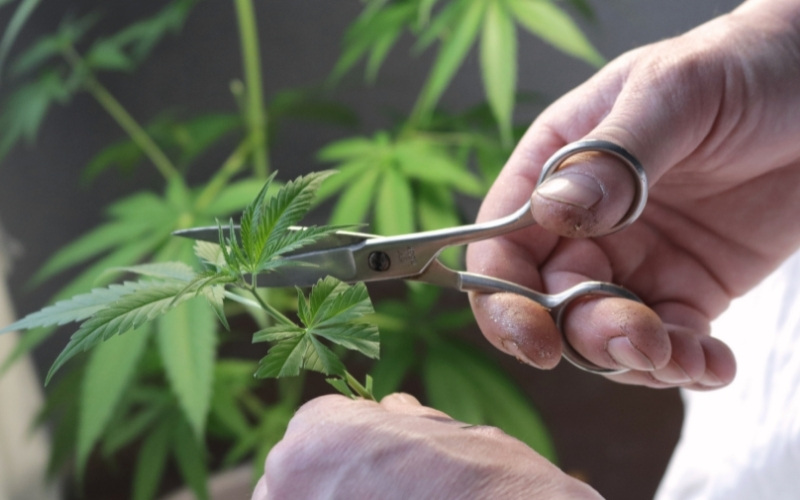
Cannabis cloning is a simple propagation method that’s both cheap and guarantees results. There are a lot of factors to consider, so it can feel overwhelming to find the right place to start. So how do you clone a weed plant? Read our comprehensive guide below to learn more.
What Is Cannabis Cloning?
Whether for recreational or medical purposes, growing weed can be rewarding, especially after experiencing a successful harvest. As a novice cultivator, reaping this reward can be tricky if you’re starting from the seed stage. Fortunately, there’s a way to fast-track this through a process known as cannabis cloning.
Cannabis cloning is when you take a “cutting” from a vegetating weed plant, allow it to establish its root system, and start the process of re-growing it. This process is asexual because the cloned plant produces similar genetic material to the mother plant without the fusion of male and female gametes.
What Are the Benefits of Cannabis Cloning?
Cannabis cloning is popular among home and commercial growers for the following reasons:
- Cost-saver – Top-shelf cannabis seeds are costly. Cloning lets you replicate your favorite weed strain at a more affordable price while saving you from having to purchase seeds frequently.
- Quality – With cannabis clones, you get the same quality as the mother plant where the “cutting” was taken.
- Fast-growing – Cloning means skipping the seed germination stage, which allows you to harvest sooner than the seeded counterparts.
How to Clone a Weed Plant: Step-by-Step Process
Knowing the cloning process means you can finally propagate your favorite type of weed strain. Here’s a step-by-step guide to how to clone a weed plant:
1. Identifying the right mother plant
With cloning, your goal is to capture the best characteristics of the selected weed strain, therefore, you must be selective when identifying the right weed plant for cloning. Generally, you’ll want to choose a mother plant with the following attributes:
- Large yield
- Strong aroma
- Mold, pest, and disease resistant
- Reasonable height if growing indoors
- Bold flavors
- Quick flowering time
- Highly potent (high THC concentration)
If you’re unsure about the overall status of the mother plant, it would help to pick cuttings from all the vegetating plants. Then, once you’ve harvested the first batch, you can decide which clones to keep based on the traits mentioned above.
2. Assemble your tools and growing components
Even before you begin the cloning process, you must determine which rooting medium to use. We recommend selecting cloning equipment that matches your growing experience. Below are the things you’ll need for the cloning process:
- A mother plant
- High-proof alcohol to serve as a disinfectant
- Cloning gel/powder
- Gloves
- Clean cutting tools such as scalpel, scissors, or razor
- Cloning tubes, domes, and trays, or foam, rockwood, or peat
- Lighting that’s preferably cool or warm white fluorescents
3. Prepare the rooting medium
There are several rooting cubes to choose from, each with its advantages and disadvantages. For instance, foam material does not affect the pH level, and you wouldn’t have to worry about waterlogging. Rockwool, on the other hand, gets waterlogged easily, but it makes up for that with its excellent airflow. Peat retains moisture and is biodegradable, so it’s good for the environment. This material, however, has trouble retaining its structure.
Whichever rooting cube you select, insert it in the tray as this will hold the water. The domes will help keep the entire setup humid.
4. Clean your tools
We can’t stress enough the importance of keeping everything clean when you’re learning how to clone a weed plant. Remember, when in a vegetating state, both the mother plant and cuttings are vulnerable to infections, therefore, to minimize the risk of spreading bacteria, you should wash your hands and put on gloves. Then using the high-proof alcohol, sterilize all cutting equipment.
5. Prepare the rooting gel/powder
A rooting gel/powder is a hormone that quickens the rooting process. It would be best to follow the instructions on the label and use it at the correct time.
6. Identify a cutting

Next, take the cutting and dip it into your rooting hormone. Proceed by placing the cutting into the rooting cube. Once secure, cut out the leaves at the bottom of the cutting. Trim the remaining leaves. Doing this will reduce the surface area and lower the evaporation rate. This helps promote water uptake and boost the process of photosynthesis.
On another note, if you’re a beginner, it would be a good idea to start by cloning one mother plant at a time. This way, you can perfect the art of cloning before selecting multiple cuttings and possibly risking an entire harvest. Equally so, always perform the cutting as the final step. As mentioned before, there’s a high risk of infection for both plants, therefore, you’d want to minimize the time a cutting remains exposed.
7. Place the cutting in a dome
Now that you have the cutting and have already inserted it into the rooting cube and tray cell, the next step is to use a dome. When rooting, a clone will require high humidity. A dome will essentially help you retain maximum humidity.
You’ll also need to leave the entire setup on an 18/6 lighting cycle where the lighting stays on for 18 hours and off for 6 hours. Alternatively, you could invest in a propagating kit for the perfect microclimate.
8. Do daily check-ins
Daily check-ins are crucial to ensure the water levels are satisfactory and all the leaves are healthy. Spray some water on the leaves if the humidity levels are low and if any clones begin dying, cut them to prevent them from growing mold.
Doing so also increases space for the remaining viable clones. It takes anywhere from 10 to 14 days for clones to root successfully. Once they achieve a 3-5cm height, you can begin the process of transplanting the clone.
9. Transplant the clone plant
The transplanting process also requires a clean environment, so, to prevent something called transplant shock, ensure everything is sterile. To transplant your clone:
- Begin by placing soil in your growing pots.
- Water the soil to prevent it from moving around and leave it to drain.
- Dig a hole that’s deep enough to cover the clone roots.
- Place your clone and then gently bury the roots with soil.
Can You Clone a Weed Plant Without Rooting Gel?
Yes, you can! Most experienced growers skip this rooting hormone to let their clones grow their roots the natural way, but if you wish to do so, it’s worth noting a few things to consider:
- Ensure your room temperature is around 23–25°C.
- You’ll need to use an opaque growing container.
- It would help to add some aspirin to speed up root development.
How Many Times Can You Clone Another Cannabis Clone Plant?
There’s no actual limit to how many times you can create clone plants from other clones. That’s because both plants are genetically identical. The only thing that will stop you from cloning another clone is if the plant dies. This is entirely dependent on the environment you create, such as providing the proper lighting and humidity conditions.
How Old Should the Mother Plant Be for Successful Cloning?
The mother plant should be in a vegetative state and at least two months old. A younger mother plant would lead to uneven growth. Also, if you pick a cutting from a flowering plant, the flowers might become premature and more susceptible to disease and mold.
Tips on Caring for a Cannabis Clone
Cannabis clone care involves creating the best environment to ensure the plant remains healthy throughout the entire process from rooting it to transplanting the clone. Typically, you’ll need to do the following:
- Ensure the water and humidity levels are as recommended.
- Remove decaying leaves immediately.
- Follow the recommended lighting cycle.
- Keep the environment sterile.
- Feed the cuttings with the proper nutrients. For instance, keeping the nitrogen levels low when rooting.
- Use willow water. Many cannabis growers use willow water to stimulate root development.
Final Thoughts
Knowing how to clone a weed plant can be an effective way to propagate your favorite cannabis strains. When done correctly, it can lead to high yields within a shorter period. Let’s not forget how much you’ll save when you clone as compared to growing the weed plant from the seed stage. If you’re thinking about becoming a cannabis cultivator, visit our site for tips on the best strains to cultivate and where to get your hands on high-quality cannabis products.

